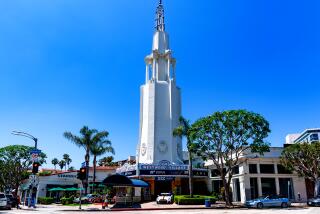Europe Flexes Its âPlexes
LONDON â Battersea Power Station, perched on the less fashionable side of the River Thames, is a huge brick building with four white towers that make it look like a giantâs upturned table.
During the last war, the bulky building proved a useful landmark to guide German aircraft toward their target of Central London. Today, property developers hope the capitalâs most famous derelict building will lure moviegoers in the opposite direction, away from the West Endâs traditional entertainment hot spots.
For 12 years developers have been searching for a commercial use for the 1920s building, protected from demolition by its official status as a historical site. Now Warner Village, a joint venture between Warner Bros., a unit of Time Warner, and Village Roadshow (the Australian media group), has provided an answer.
They plan to build a $56-million, 32-screen movie house at the power station that will seat 8,200. Unveiling the proposals, Warner Bros. International President Millard Ochs said the âpowerplexâ would transform moviegoing in the capital by providing an alternative to the dominant entertainment center based in the West End. Lantana, a Los Angeles-based post-production film company, also plans to have a studio on the site.
*
Battersea claims to be Britainâs first megaplex (a theater with more than 12 screens) and is one of several movie theater developments springing up across Britain and the rest of Europe as foreign investors--many from the U.S.--pile into a marketplace that has lagged North America.
The rapid spread of more comfortable and inviting movie theaters in Europe and Asia is one of the top reasons for strong global growth in the movie business. Many of Hollywoodâs blockbusters now earn more internationally than they do in the U.S., where multiplexes (a theater with five or more screens) are becoming as common as strip malls.
Britainâs first multiplex opened in Milton Keynes in 1985 and, since then, according to entertainment consultants Dodona Research, the number of multiplex screens there has jumped to about 1,184. Karsten-Peter Grummitt, managing director of Dodona Research, believes part of the reason is connected with the property cycle.
âOffice and retail property is not doing so well, and developers are looking for something to do.â
Movie houses are also seen as good anchors for leisure developments because they attract other tenants. Warner Village looks to be the first big name at Battersea, but the complexâs developers also plan two hotels, two theaters, offices and homes on the 35-acre site.
Rising attendance figures also have persuaded cinema chains to expand. Odeon, which opened its first British movie house in 1930 and is now one of the biggest operators, with 74 houses and 380 screens, is reported to be spending $240 million over the next five years on new multiplexes and on refurbishing its existing inner-city sites.
âWhen video first came out in the early â80s, admissions were on a major decline; everyone was scared and nervous; and a number of cinemas looked tired,â Odeon Cinemas managing director Richard Segal said.
âWhile itâs obvious that the big blockbusters have been of great importance to the prosperity of the cinema industry, wider customer choice is also growing, and we can now offer much nicer facilities in which to go and see a film.â
*
Attendance figures at movie houses appear to confirm this view. Figures from the European Audiovisual Observatory show that admissions in the European Union jumped by 7.3% to 706 million last year. In Britain, they stood at 124 million (an increase of 7.75% over the previous year), compared with 120 million in Japan and 1.26 billion in the U.S.
Dodona forecasts that attendance levels will rise to 180 million in Britain by the end of the millennium. Some forecasters even suggest that Britain could eventually reach 300 million. Annual per capita cinema visits in Britain are running at about two, compared with four in the U.S. and five in Australia.
In Europe, Britain lags Germany, which reported 133 million cinema admissions last year, and France, which topped 136 million. Optimists believe Britain can overtake both countries to produce the busiest box office.
Britain already has by far the highest percentage of cinemas with five screens or more--just under 60% of its total at the end of last year. France had 18.4% and Germany 10.5%. In Italy, only 1% of all screens were multiplexes.
The North American market is now seen as mature and movie chains such as Warner Bros. are setting their sights on Europe. Warner, which came to Britain eight years ago, has 17 movie houses and plans to add 23 more by 2000 as well as 275 more in Germany, France and Italy over the next three years. The company already has eight houses in Spain, Portugal and Germany.
UCI, a joint venture between Universal and Paramount, is also embarking on a second wave of new building in Britain and expansion in Germany, Spain, Austria and Italy. Executives believe the boom is partly because of an increase in the number of blockbuster movies in recent years that demand state-of-the-art sound and screen quality offered by modern movie houses.
The British Film Institute estimates that average revenues per screen (including advertising, box-office takes and concession sales) in Britain are more than $300,000--easily the highest in Europe. Some distributors, though, still find the British market a hard one to crack.
John Wilkinson, chief executive of the Cinema Exhibitors Assn., believes the rush to build theaters in Britain is leading some operators to choose the wrong sites.
âItâs very aggressive out there, and itâs important to have a good market share,â he said. âSome groups are coming in from abroad and being tempted by sites that more seasoned operators might reject.â
Multiplexes, too, rarely offer fast returns on investment in Britain, where research shows that it can take two to three years to build an audience. Usually admissions in the first year are 70% of the level in the third year.
âI donât think there is a market for new cinemas in all parts of the country. Many areas are over-screened and some cinemas will close within the next 12 to 18 months,â Segal said.
Battersea is seen as a prime London site but, should audiences fail to flock to Londonâs most unusual movie theater, the power station can always revert to an earlier use. While it waited to be snapped up by the entertainment industry, its futuristic architecture made it a popular location for shooting the movies âSupermanâ and âRichard III.â
More to Read
Inside the business of entertainment
The Wide Shot brings you news, analysis and insights on everything from streaming wars to production â and what it all means for the future.
You may occasionally receive promotional content from the Los Angeles Times.










